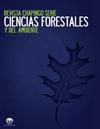Population structure and spatial distribution of oregano (Lippia graveolensH. B. K.) at the Tehuacán-Cuicatlán Biosphere Reserve, Mexico
IF 0.6
4区 农林科学
Q3 Agricultural and Biological Sciences
Revista Chapingo Serie Ciencias Forestales Y Del Ambiente
Pub Date : 2022-04-30
DOI:10.5154/r.rchscfa.2021.04.024
引用次数: 0
Abstract
Introduction:Oregano (Lippia graveolens H. B. K.) grows in semi-arid ecosystems. There is no information on the population dynamics of this species at the Tehuacán-Cuicatlán Biosphere Reserve (RBTC). Objective: To determine the vertical structure and spatial distribution of L. graveolens in five topographic conditions in the RBTC. Materials and methods: Ten sampling units were established in five topographic conditions (TC), where six plant height categories were defined. Density and structural variables were measured, from which IVI was obtained and population structure curves were constructed. The spatial distribution pattern was analyzed with the Ripley’s transformed function (L(t)). Results and discussion: TC1 showed population curve type IV (low frequency in the first, third and fourth height categories, high in the second and fifth categories, and low in the rest) with lower density (100 plants∙ha-1; 1.6 %) in category 6 (>251 cm), and higher density (1 840 plants∙ha-1;29 %) in category 4 (151 a 200 cm). For TC2 to TC5, the curve was V-type (low frequency in the first category, gradual increase up to the intermediate category, and gradual decrease in the rest) with lower density (20 plants∙ha-1; 0.4 %) in category 6, and higher density (2 320 plants∙ha-1; 51 %) in category 4 which also had the highest IVI (92.8 to 126.1). Spatial distribution was aggregated in TC1 to TC4 and randomized in TC5. Conclusions: Topographic conditions influenced the vertical structure and spatial distribution of oregano.墨西哥Tehuacán-Cuicatlán生物圈保护区牛至(Lippia graveolensH.B.K.)的种群结构和空间分布
简介:牛至生长在半干旱生态系统中。Tehuacán-Cuicatlán生物圈保护区(RBTC)没有关于该物种种群动态的信息。目的:确定RBTC五种地形条件下graveolens乳杆菌的垂直结构和空间分布。材料和方法:在五种地形条件下建立了十个采样单元,其中定义了六种植物高度类别。测量密度和结构变量,由此获得IVI并构建群体结构曲线。利用Ripley变换函数(L(t))对空间分布模式进行了分析。结果和讨论:TC1显示IV型种群曲线(第一、第三和第四高度类别的频率较低,第二和第五类别的频率较高,其余类别的频率低),第6类(>251厘米)的密度较低(100株∙ha-1;1.6%),第4类(151 a 200厘米)的密度较高(1 840株∙ha-1;29%)。对于TC2至TC5,曲线为V型(第一类频率较低,逐渐增加到中间类,其余部分逐渐减少),第6类密度较低(20株;0.4%),第4类的密度更高(2 320株;51%),IVI也最高(92.8至126.1)。TC1至TC4的空间分布汇总,TC5的空间分布随机化。结论:地形条件影响牛至的垂直结构和空间分布。
本文章由计算机程序翻译,如有差异,请以英文原文为准。
求助全文
约1分钟内获得全文
求助全文
来源期刊
CiteScore
1.20
自引率
16.70%
发文量
0
审稿时长
>12 weeks
期刊介绍:
The Revista Chapingo Serie Ciencias Forestales y del Ambiente (RCHSCFA) is a scientific journal that aims to raise awareness of high-quality research products related to forest, arid, temperate and tropical environments in the world. Since its foundation in 1994, the RCHSCFA has served as a space for scientific dissemination and discussion at a national and international level among academics, researchers, undergraduate and graduate students, forest managers and public/private entities that are interested in the forest environment.
All content published in the journal first goes through a strict triple-blind review process and is published in the following formats: Scientific Articles, Review Articles, Methodologies, Technical or Technological Notes.

 求助内容:
求助内容: 应助结果提醒方式:
应助结果提醒方式:


